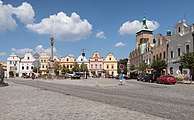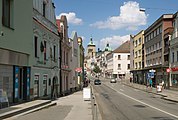Havlíčkův Brod
This article includes a list of general references, but it remains largely unverified because it lacks sufficient corresponding inline citations. (March 2012) |
Havlíčkův Brod | |
|---|---|
Town | |
 Havlíčkovo Square seen from the tower of the Church of the Assumption | |
 Flag  Coat of arms | |
 Havlíčkův Brod Location in the Czech Republic | |
| Coordinates: 49°36′21″N 15°34′43″E / 49.60583°N 15.57861°ECoordinates: 49°36′21″N 15°34′43″E / 49.60583°N 15.57861°E | |
| Country | |
| Region | Vysočina |
| District | Havlíčkův Brod |
| First mentioned | 1256 |
| Government | |
| • Mayor | Jan Tecl (ODS) |
| Area | |
| • Total | 64.95 km2 (25.08 sq mi) |
| Elevation | 422 m (1,385 ft) |
| Population (2020-01-01[1]) | |
| • Total | 23,442 |
| • Density | 360/km2 (930/sq mi) |
| Time zone | UTC+1 (CET) |
| • Summer (DST) | UTC+2 (CEST) |
| Postal code | 580 01 |
| Website | www |
Havlíčkův Brod (Czech pronunciation: [ˈɦavliːtʃkuːv ˈbrot]),[2] until 1945 Německý Brod (Czech pronunciation: [ˈɲɛmɛtskiː ˈbrot]; German: Deutschbrod) is a town in Havlíčkův Brod District in the Vysočina Region of the Czech Republic. It has a population of about 23,000. It is located roughly in the geographical centre of the country, on the Sázava River in the Bohemian-Moravian Highlands.
Name[]
The Czech word Brod means "ford" in English. The settlement became a town in the mid 13th century and for distinction from another places of the same name it was firstly named Smilův Brod ("Smil's Ford") after its founder Smil of Lichtenburk. However, later it became called Německý Brod ("German Ford", German: Deutschbrod) because of its predominantly German population, and as the opposite of Český Brod ("Czech Ford") near Prague. The Germans made up most of the population of the town since 13th until the first half of 15th century. Because of Anti-German sentiment after World War II, the town was renamed Havlíčkův Brod ("Havlíček's Ford") in honor of the 19th century writer and publicist Karel Havlíček Borovský, who was born in nearby village and grew up and studied in the town. It is one of very few examples of personal honorification in Czech toponymy. The rather long official name is commonly abbreviated HB, or colloquially Havlbrod or just Brod (when there's no need to distinguish).
History[]
Settlement in Brod has been documented as far back as the 12th century. After silver was discovered in the area, the Bohemian nobleman Smil of Lichtenburk (Lichtenburg) invited German miners to settle the area; Brod received its town rights in 1274. Although the townspeople were German-speakers in a predominantly Czech-speaking land, the people of Brod became loyal subjects of the Bohemian crown. In the 13th and 14th centuries it was a center for silver mining, although its importance gradually declined in the latter century. Because the German townspeople supported King Sigismund during the Hussite Wars, Brod was sacked on 22 January 1422 by Jan Žižka. The town was resettled by predominantly Czech-speaking population in 1429 and experienced a cultural flowering during the 16th and 17th centuries. Since 1429 the majority of the town's population was ethnically Czech. Until 1918, the town was part of the Austrian monarchy (Austria side after the compromise of 1867), head of the Deutschbrod – Německý Brod District, one of the 94 Bezirkshauptmannschaften in Bohemia.[3]
Brod was industrialized during the 19th century with an emphasis on textiles. Railway came here in 1870 and the station later became an important hub.
After the World War II, the town was renamed Havlíčkův Brod.
Havlíčkův Brod today[]
From the town's main plaza a skeleton is readily visible at the top of the town hall's tower. The town contains both a medical hospital and a mental hospital.
Transport[]
Havlíčkův Brod is both road and railway hub. There are five rail lines leading off the main station: to Kolín and Prague (operating since 1870), to Pardubice (1871), to Brno (1898), to Jihlava (1871) and a local line to Humpolec (1894). Historically, the main line running through the town was Vienna-Znojmo-Jihlava-Kolín, but after WWII the line to Brno was rebuilt, made double-track and electrified, and Praha-HB-Brno became one of main passenger and freight train routes in Czechoslovakia. Though at the turn of 20th and 21st centuries its importance dropped, as all international expresses were transferred to the 1st National Railway Transit Corridor (via Česká Třebová), it is still a relevant alternative route.
The town is also a crossing of two major Czech roads, No. 34 from České Budějovice to Svitavy and No. 38 from Mladá Boleslav to Jihlava and Znojmo (and on to Vienna). The D1 motorway Praha-Brno is accessible by both of these roads (exits are about 20 km from HB).
Sights[]
The town centre is well preserved and historically significant and since 1990 is protected by law as Urban monument zone.
Notable people[]
- Jan František Beckovský (1658–1725), historian, writer and translator
- Ignác František Mara (1709–1783), cellist and composer
- Johann Stamitz (1717–1757), composer and violinist
- Josef Dobrovský (1753–1829), philologist and historian; studied here
- Karel Havlíček Borovský (1821–1856), writer and poet; lived here
- Bedřich Smetana (1824–1884), composer; studied here
- Karel Barvitius (1864–1937), publisher
- Václav Klofáč (1868–1942), politician
- Vilém Kurz (1872–1945), pianist
- Jan Zrzavý (1890–1977), painter
- Pavel Landovský (1936–2014), actor
- Jaroslav Holík (1942–2015), ice hockey player and coach
- Jiří Holík (born 1944), ice hockey player and coach
- Jan Suchý (born 1944), ice hockey player
- Josef Augusta (1946–2017), ice hockey player and coach
- František Janák (born 1951), glass artist
- Pavel Poc (born 1964), politician
- Lenka Šmídová (born 1975), sailor, Olympic medal winner
- Josef Marha (born 1976), ice hockey player
- Radek Martínek (born 1976), ice hockey player
- Petr Zelenka (born 1976), serial killer
- Jan Novák (born 1979), ice hockey player
- Tomáš Zdechovský (born 1979), politician
- Josef Vašíček (1980–2011), ice hockey player
- Antonín Dušek (born 1986), ice hockey player
- Hynek Zohorna (born 1990), ice hockey player
- Tomáš Souček (born 1995), footballer
- Radim Zohorna (born 1996), ice hockey player
- Vítek Vaněček (born 1996), ice hockey player
Twin towns – sister cities[]
Havlíčkův Brod is twinned with:[4]
 Brielle, Netherlands (1985)
Brielle, Netherlands (1985) Brixen, Italy (1992)
Brixen, Italy (1992) Spišská Nová Ves, Slovakia (1995)
Spišská Nová Ves, Slovakia (1995)
Partner towns[]
Havlíčkův Brod also cooperates with other Brods in the Czech Republic: Český Brod, Široký Brod, Uherský Brod, Vyšší Brod and Železný Brod.[4]
Gallery[]

Havlíčkovo Square

Marian column at the Havlíčkovo Square

Dolní street
See also[]
References[]
- ^ "Population of Municipalities – 1 January 2020". Czech Statistical Office. 2020-04-30.
- ^ In isolation, Havlíčkův is pronounced [ˈɦavliːtʃkuːf]
- ^ Die postalischen Abstempelungen auf den österreichischen Postwertzeichen-Ausgaben 1867, 1883 und 1890, Wilhelm Klein, 1967
- ^ Jump up to: a b "Partnerská města". muhb.cz (in Czech). Město Havlíčkův Brod. Retrieved 2020-08-24.
External links[]
- (in Czech) Official website
![]() Media related to Havlíčkův Brod at Wikimedia Commons
Media related to Havlíčkův Brod at Wikimedia Commons
- Havlíčkův Brod
- Populated places in Havlíčkův Brod District
- Cities and towns in the Czech Republic




